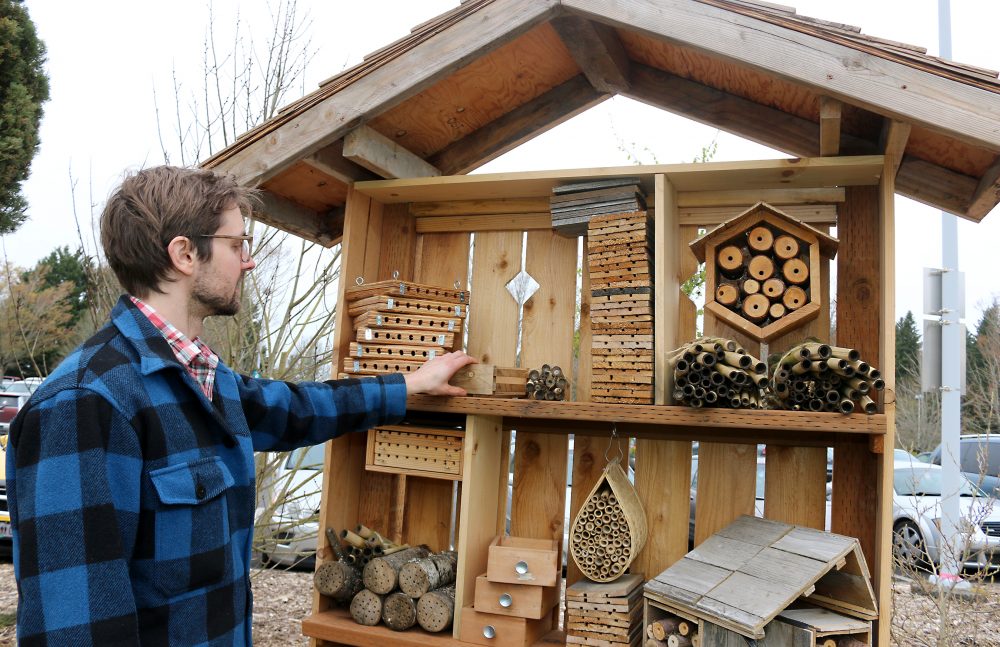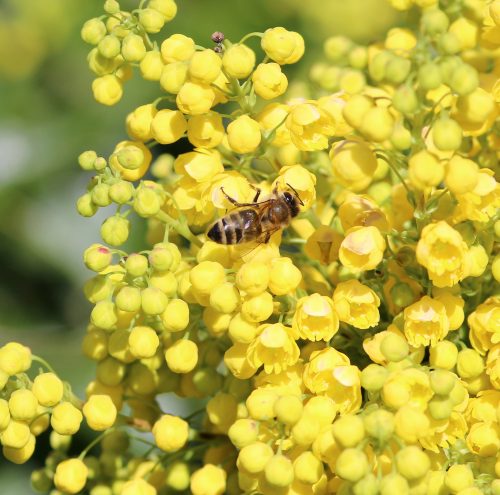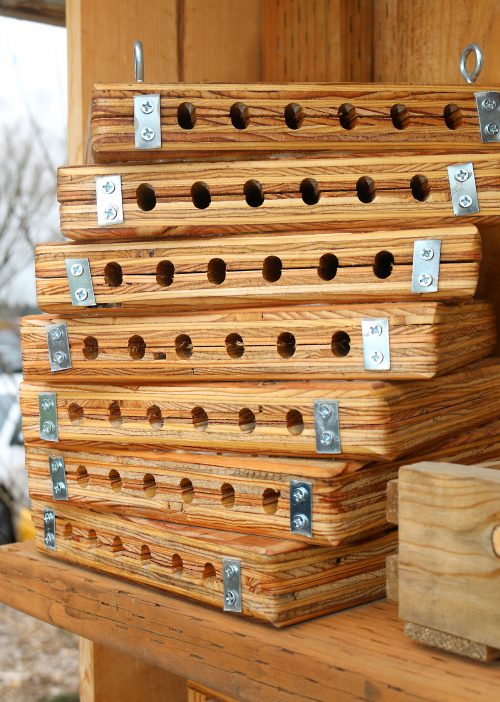This content was published: April 30, 2018. Phone numbers, email addresses, and other information may have changed.
3D design class tackles critical sustainability project to assist mason bees
Photos and Story by Janis Nichols
 The hotel’s design had a long list of “musts.” It had to be cost effective, it needed to consider form and function equally, and its design required a simple yet attractive look, with easy access.
The hotel’s design had a long list of “musts.” It had to be cost effective, it needed to consider form and function equally, and its design required a simple yet attractive look, with easy access.
Ladies and gentlemen, we give you the Mason Bee Hotel Project at Portland Community College’s Rock Creek Campus.
The “3D Design” class, taught by Rock Creek art instructor Will Moss, collaborated with the college’s Sustainability Program and the Rock Creek Learning Garden on the effort. The garden needed to increase the number of mason bee pollinators to elevate food production more sustainably. Enabling students taking 3D design — a staple in visual arts programs for the past 50 years — to be involved, provided them with a unique challenge that offered real, long-term environmental consequences.
“The class has several goals,” said Moss, who will offer the three-credit 3-D design class again this summer. “It gives students a framework to discuss three dimensional compositions. There is an emphasis on the development of confidence related to construction methods that use everyday basic materials, like cardboard, plaster, wire and stone, yet remain abstract and non-representational. And the class is about learning a new vocabulary, both verbal and hands on.”
It appeals to a variety of students — those who take the course as a pre-requisite for graphic design or product design, and those who may seek careers in architecture or sculpture. The bee hotel was the final project for the class, and students, as expected, approached the assignment with varying levels of interest and from different perspectives.
“Some students were mildly intrigued, while others were more enthusiastic,” Moss said. “We spent time in the garden learning how it functioned, and we were shown some hives already in place. Back in the classroom, we discussed the needs of the bees and the technical issues involved. Students worked in groups, sketching with paper and pencil.”
As with any group project, some students kept the hotel design simple, while others leaned into more complicated and sophisticated concepts. And when students remembered they could find themselves building what they designed, the process became more selective.
“It’s a time and skill equation,” said Moss. “There were students who committed to a more complicated design, and there were others who had big dreams, then compromised. The incentive for all of them, however, has been knowing they are creating something with a purpose that will be part of the learning garden for many years to come.”
The Mason Bee Hotel in the learning garden serves as a birth place for these bees. There are approximately 150 mason bee types in North America, and the “busy as a bee” expression is founded on the fact that as few as 200 to 300 females can pollenate an acre of apple or cherry trees. These bees play a key role in the country’s agricultural output.
In the world of pollinators, the mason bee is the first to appear in early spring. They only live for six weeks, so they must be very efficient with their time. The female hunts for pollen and nectar from fruit trees, berries, vegetables and flowers. She packs this food deep into a nesting cavity where she then deposits an egg and seals the cell with mud. She repeats the process — food, egg, cell mud, food, egg, cell mud — until the cavity is full. The female flies off to die, and the larvae hatch a few days later. For about 10 days, they eat the food that was stored for them in the cavity by the adult female. The larva spins a cocoon and pupates. They stay in the hive through the winter, emerge with the warmth of spring, mate, and start the process all over again.
These bees are friendly and hard working. They don’t make honey. They are very low maintenance yet play a significant role in the strength and consistency of the world’s food chain.
However, you don’t have to take a 3D design class to participate in what has become a national effort. Mason Bee Hotels have become “a thing” in Oregon.
“Homeowners and bee keepers have joined forces to create habitat for these bees,” said Anne LeSenne, Landscape Technology instructor and bee keeper at Rock Creek. “We have a fabulous Mason Bee Boutique in the Learning Garden. These beautiful hives are inexpensive to build and are a great way to introduce people to bees and to science.”
Master Gardeners Relocate to Rock Creek Campus
The Washington County Gardeners Association, with its demonstration gardens and renowned annual plant sale, has left its home at the fairgrounds in Hillsboro to plant a flag at PCC Rock Creek.
The demonstration garden features a series of vignette gardens showcasing a variety of gardening styles and methods that reflect the Master Gardener philosophy of sustainable gardening practices.
The new partnership also invites collaboration between the Master Gardeners and faculty, students and staff in the Landscape Technology program at Rock Creek.
“This is a great partnership for this campus,” said Rock Creek Dean Karen Sanders. “The campus will have direct access to the association’s educational program, ‘In the Garden Series,’ that will include workshops on bees, blueberry pruning, propagation and managing garden pests. All the workshops are open to anyone who has an interest in gardening, including the general public.”
The new Master Gardeners site is next to the Learning Garden at Rock Creek. The association took possession of the plot on March 1 and is already hard at work preparing it. An official groundbreaking will take place in either May or June.


This is so wonderful to see happening. I wonder what the “most successful” design aspects ate when considering nesting bee habitat and behavior. I hope this bee garden overflows with bee life!
Howdy: I a PCC Double Alumni! Found this to be interesting, but a couple corrections need to be address. The Picture show is “Italian” Bee,not a Mason Bee! Secondly,Mason Bee, is not Hive Bee, like the Italians and other similar varieties. The statement of how they nest, did not address the difference well enough to show this nesting style.
Lastly they never mentioned one of the deadly threats to Mason Bees, is a little wasp, who drills a hole thru the sealed mud, goes in, kills the larvae of the Mason Bee…and leaves a yellow stain on the outside of the murdered cell!
The only way to protect the baby Mason Bees is after your hotel housing them is to put them away where flying wasps cannot find, to over winter or screen over the mud entrances to protect with very small window screens (Fiberglass) works well stapled to wood edges. Then take them out when Spring gets closer!
Thanks, Tom Kelly
How fantastic is this? As a former Master Gardener, I am so pleased to learn this. My neighbors and I go to the annual Master Gardener Plant Sale. It is fabulous!
Thank you Tom Kelly for the pointers on types of bees and protection.